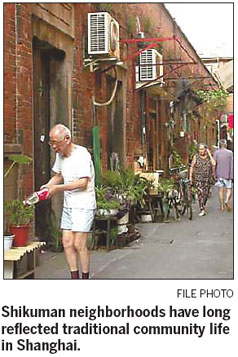Shikumen tradition preserved
By Shi Yingying (China Daily)
Updated: 2010-05-06 10:41
 |
Large Medium Small |
In a tranquil corner of the former French Concession area of Shanghai is the largest existing cluster of historic Shikumen style houses. Since 2008, they have been undergoing a major restoration.
The Jianyeli residential neighborhood has nearly 200 eighty-year-old houses of this hybrid Western and Chinese style and the restoration project has brought more than construction noise to local residents.
"I read in the newspaper that after completion, these houses will sell for 130,000 yuan ($19,039) per square meter," says 60-year-old resident Sun Zhangmu, who lives next door to the Jianyeli neighborhood.
"People who used to live here can no longer afford to do so," he says. "With this new wealth and foreign residents, it's not going to be the same Jianyeli - at least not the one we're familiar with," he adds.
Famous for its rich street life, street food and open-air markets, Shikumen neighborhoods had long reflected traditional community life in the city. In the early 20th century, up to 80 percent of the city's population lived in these two or three-story townhouses with an inner courtyard protected by a high brick wall.
Today only a few neighborhoods, such as Xintiandi and Tianzifang had some Shikumen houses protected before they were redeveloped into a bar area, art zone and residential area.
Sun says it is a shame to see these old-style houses are disappearing.

However, Professor Zheng Shiling, honorary president of the Architectural Society of Shanghai and consultant of Expo 2010 Shanghai, has a different perspective.
"Unlike the purely commercial use of Xintiandi or even mixed use, Jianyeli remains true to what it was, which is a residential neighborhood," Zheng says.
"Apart from that, it is important to remember these buildings were constructed in the 1930s. It's going to be very difficult for them to survive the next 100 years without renovation and special care, especially during the rainy season," Zheng adds.
Benjamin Wood, whose first project in Shanghai was Xintiandi, believes in adapting these old communities to meet the demands of contemporary society.
"We should not treat old buildings as ancient relatives whom we felt close to as children, and when we grow up, want to preserve them in death as embalmed cadavers," says the head of Benwood Studio Shanghai, who called himself a "futurist" instead of "preservationist".
"It's all about how to give these cultural artifacts a future and a new life," he adds.
As to the Jianyeli restoration project, the Jianyeli project, Wood says, "(The architect John) Portman has always been famous for his visions of the future. His Jianyeli development will most certainly breathe new life into some venerable Shanghai Shikumen."